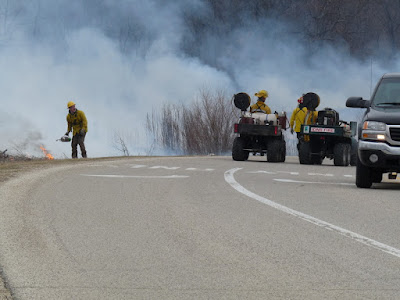Our first day in the park was eventful as a state DNR heritage biologist and a state forester were conducting a controlled burn as part of their forestry management plan.
Prescribed burning is beneficial for forest health and wildlife habitat, as well as for public safety through reduction in frequency and severity of wildfires. Burning helps many open-land wildlife species by stimulating new grass growth that these and other animals use for nesting and hiding and retards the growth of brush and trees which can overtake open areas and crowd out some animal and plant species.
Early spring, when frost is still in the ground and before nesting season has begun, is the safest time to burn. These will be the first areas to green-up, providing lush meadows and grasslands for nesting and food.
These are professional foresters, biologists and firefighters working as a coordinated team with a well thought-out management and burn plan. Notice the dark water marks on the fence posts, the direction of the smoke pattern away from the roads and the road patrol for smoke across the main road. A helpful rain was forecast and did occur a few hours after this burn.
A typical burn team has one igniter--
--one or two members to control the fire line--
--and one to mop up.
These are special all-terrain vehicles with enough equipment and water to control this type of fire.
An igniter at the end of the torch serves as a continuous flame to ignite drops of fuel which fall to the vegetation as the torch is tilted toward the ground.
Tallgrass prairies and open brushlands are kept free of trees by occasional wildfires.
Fire sets back or kills encroaching woody plants but does no harm to prairie grasses, whose roots extend deep beneath the ground surface.
The road acts as a fire line-
--while drip torches ignite and set the burn pattern.
The team closely monitors their progress and makes sure the burn is going as planned.
They are also set up and prepared to fight any local wildfires.
The burn is done in planned phases with each one being under control before the next one is begun.
A fuel ratio of 70% diesel/ 30% gasoline is used for warm weather and 60/40 for cool weather. The higher the air temperature the less gas is needed.
The drip torch is the easiest and safest way to ignite an even fire line. This igniter has to keep going and always know his escape route.
Dense smoke could be seen for miles-
 -
---and local police provided road patrol where needed.

After a burn the blackened soil quickly absorbs sunlight, the warmed earth encourages seed germination--

--charred plant remains turn into a rich fertilizer--

--and new grass quickly sprouts from the network of root systems deep in the ground.

This is the same field two weeks later.
Our host campsite for the month of April.































1 comment:
I always enjoyed the controlled burning at Moraine Hills, it's a sight to see.
Post a Comment